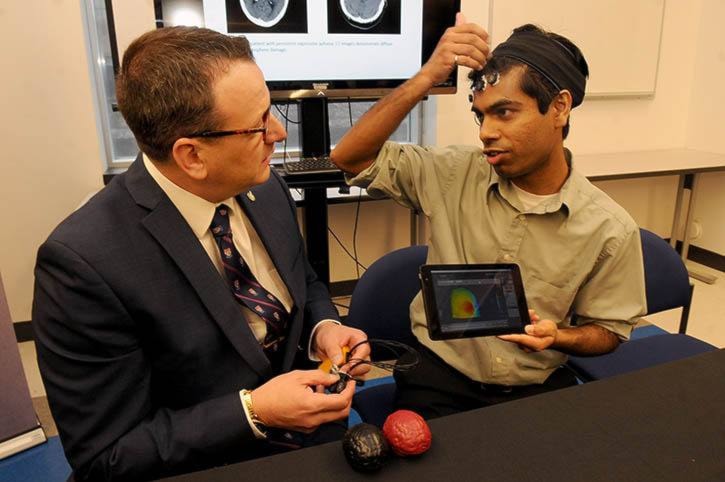A hockey player who’s just had his bell rung could soon get the green light to stay in the game, or the red light to go the dressing room, as soon as he gets back to the bench.
He may not even have to remove his helmet.
Ryan D’Arcy, a neuroscientist at Simon Fraser University, is developing a portable device that can diagnose brain trauma quickly and simply, allowing coaches and trainers to take the guesswork out of determining when a player has suffered a concussion.
D’Arcy, who holds a research chair at Surrey Memorial Hospital, said his Halifax Consciousness Scanner (HCS) is essentially a micro-sized electroencephalograph (EEG) that uses sensors placed on the head to record the brain’s electrical activity. But instead of generating complicated graphs or 3-D maps that only a physician could interpret, computer algorithms interpret the data to give a green light that the patient isn’t concussed, a red light that there is a concussion, or a yellow light for further examination.
D’Arcy’s work is being partially funded by a $380,000 grant from the Canada Foundation for Innovation’s John R. Evans Leaders Fund. Greg Rickford, the Minister of State (Science and Technology) was at the SFU campus on Wednesday to announce a $63 million federal investment in research projects like D’Arcy’s. In total, SFU will receive $1 million of that funding for six projects.
D’Arcy, who previously developed a portable device that will scan electrical activity of severely brain-injured patients in a vegetative state to help doctors and families determine further treatment, said his lightbulb moment came when he determined there was no reason such a device couldn’t become even more portable and easier to operate. That would enable it to be put in the hands of the general public, and especially athletic coaches and trainers, to give them an objective tool to determine whether an athlete is concussed rather than relying on a subjective reading of on-the-spot tests, like looking into their eyes, or asking a series of simple questions.
“We need to get this out of the hospitals and deploy the technology where it needs to be,” said D’Arcy, who’s also partnered with the Mayo Clinic.
The first prototype of the HCS was about the size of a toaster and needed wires to connect to the array of sensors placed on the patient’s head. The second generation is wireless and uses a handheld tablet to record and analyze the data. The next version will be no bigger than a cellphone. And eventually the sensors could be integrated directly into helmets.
D’Arcy said that technology is already a part of the helmets worn by fighter pilots.
“That’s the vision, that’s the dream,” he said.
And while getting to that point will take time, D’Arcy said when he gets there the outcomes for athletes who’ve taken a blow to the head will be improved.
“I love the idea of changing the world to make it better,” said D’Arcy. “We have the technology to do that.”
